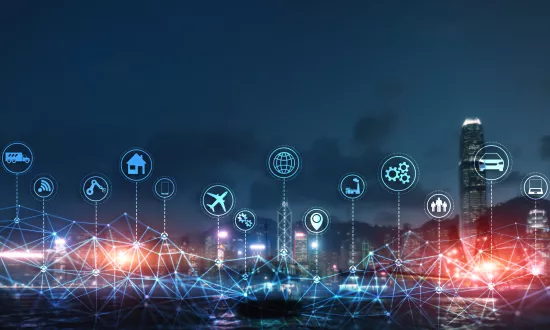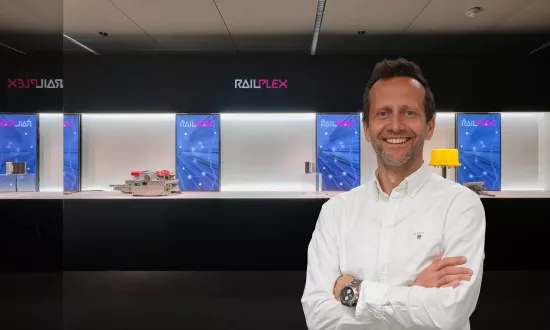What does 5G mean for metros?
New radio technology is
a game changer for urban rail!
Mention 5G and the first thing most of us think of is smartphones. 5G’s high speed and massive data-handling capacity is a huge attraction for consumers. Not surprisingly, the number of people taking advantage of 5G is growing every day.
But there’s much more to 5G than faster consumer applications. Industrial users – such as car manufacturers and oil & gas – are already realising the benefits of 5G thanks to Industry 4.0 applications that tap into 5G’s unrivalled speed, bandwidth and in-built capacity to support IoT (Internet of Things) applications.
Metro operators are also taking a keen interest in 5G technology – particularly when it comes to supporting modern signalling systems that rely on continuous train-to-ground radio connectivity. Thales’ SelTrac™ CBTC (Communications-Based Train Control) is an example. So what makes 5G such an attractive candidate for signalling applications?
5G benefits for metro operators
Seamless radio connectivity, lower lifecycle costs and scope for data analytics are just some of the attractions of 5G.
- High-performance connectivity: 5G offers excellent radio performance with lossless handover. This means that it performs reliably even in challenging environments, such as tunnels. For this reason, 5G is particularly valuable in safety-critical applications such as CBTC that demand ultra-high availability and seamless coverage.
- Reduced lifecycle costs: operators can make use of public 5G networks – eliminating the cost of building and maintaining a bespoke radio access network of their own. Meanwhile, 5G’s superior technical characteristics means that less wayside equipment is required, with hardware reduced by 60% or more compared to conventional Wi-Fi radio.
- Wireless supervision: 5G is typically seen as a mobile technology. But it can be used with fixed assets as well, such as interlockings and point machines – potentially eliminating hundreds of kilometres of copper and fibre optic cable. Moreover, embedded 5G could can allow assets to communicate directly with each other, reducing the need for central supervision and paving the way to the Internet of Train Things.
- Analytics on the move: 5G’s speed and bandwidth provides opportunities for data-intensive applications – including real-time monitoring of CBTC subsystems. 5G makes it possible to gather data from moving trains to generate logs, reports and alerts, boosting the efficiency of operations and maintenance activities. Moreover, it eliminates the need for manual data collection from trains – a time consuming and expensive exercise.
- Cybersecurity: implementing 5G is transformative from a cybersecurity perspective – particularly if a multi-service network is used to replace several existing radio access networks. First and foremost, it reduces the number of communications systems that require patches and upgrades. In addition, 5G opens up greater opportunities for cybersecurity monitoring and remote patching.
- Expansion without limits: 5G can accommodate any mix of radio traffic. This means that an operator who initially chooses to deploy a 5G network for signalling can use the same infrastructure to provide new services, without having to add new radio infrastructure in tunnels.
- Future-proof connectivity: 5G is supported by 3GPP – a consortium of standards organisations dedicated to the development and maintenance of mobile telecommunications protocols, so operators can be confident that future iterations of 5G technology (6G is expected after 2030) will be backwards compatible. This matters, because a radio access network needs to have a life equal to that of the signalling system it supports – typically upwards of 30 years.
How can Thales help?
Whether you choose to deploy private 5G infrastructure or take advantage of existing public networks, Thales has everything you need.
- 5G radio access networks: Thales designs, builds and deploys 5G data communications systems that are optimised for rail and tailored to the precise needs of the customer. Our offer includes deployment of radio access points in tunnels and at the wayside, fibre backhaul, and management of the 5G core.
- Connecting trains to data networks: our Modular Communications Gateway (MCG) provides secure train-to-ground connectivity for all your onboard applications – including mission-critical applications that require priority latency, such as CBTC. With MCG, operators can take advantage of both public and private 5G networks for their train control needs.
- End-to-end cybersecurity: Thales addresses cyber threats with an end-to-end security architecture that protects all layers of the network infrastructure, guaranteeing the safety of systems as well as data integrity. All of our solutions are Cybersecured by Design.
At Thales, we are dedicated to helping you to get the most out of 5G – boosting reliability, providing attractive journeys for your passengers and building a future we can all trust.
Thales selected for major 5G deployment
Thales is to deploy a flexible and futureproof 5G radio solution on one of the world’s busiest metro networks as part of a major resignalling programme.
The project will see the deployment of Thales’ SelTrac™ Communications-Based Train Control (CBTC) along with a new 5G Data Communications System (DCS). The new 5G system – which provides train-to-ground communications – will play a critical role in delivering reliable and high-capacity CBTC operations.
The project will be one of the first to incorporate 5G radio for mission-critical signalling applications. Thales will maintain the system for 25 years and provide obsolescence management. Once in operation, 5G radio will play a decisive part in delivering safe, reliable and attractive journeys for tens of thousands of passengers every day.


